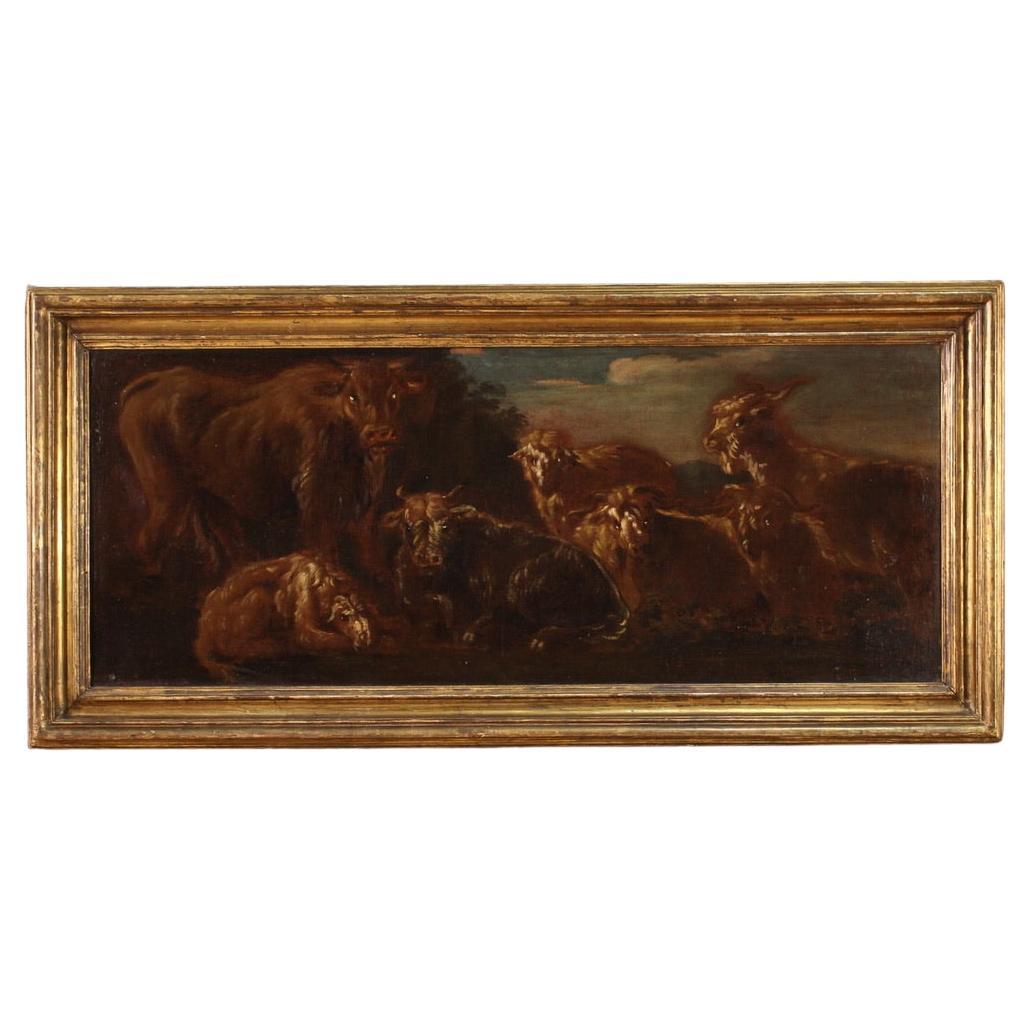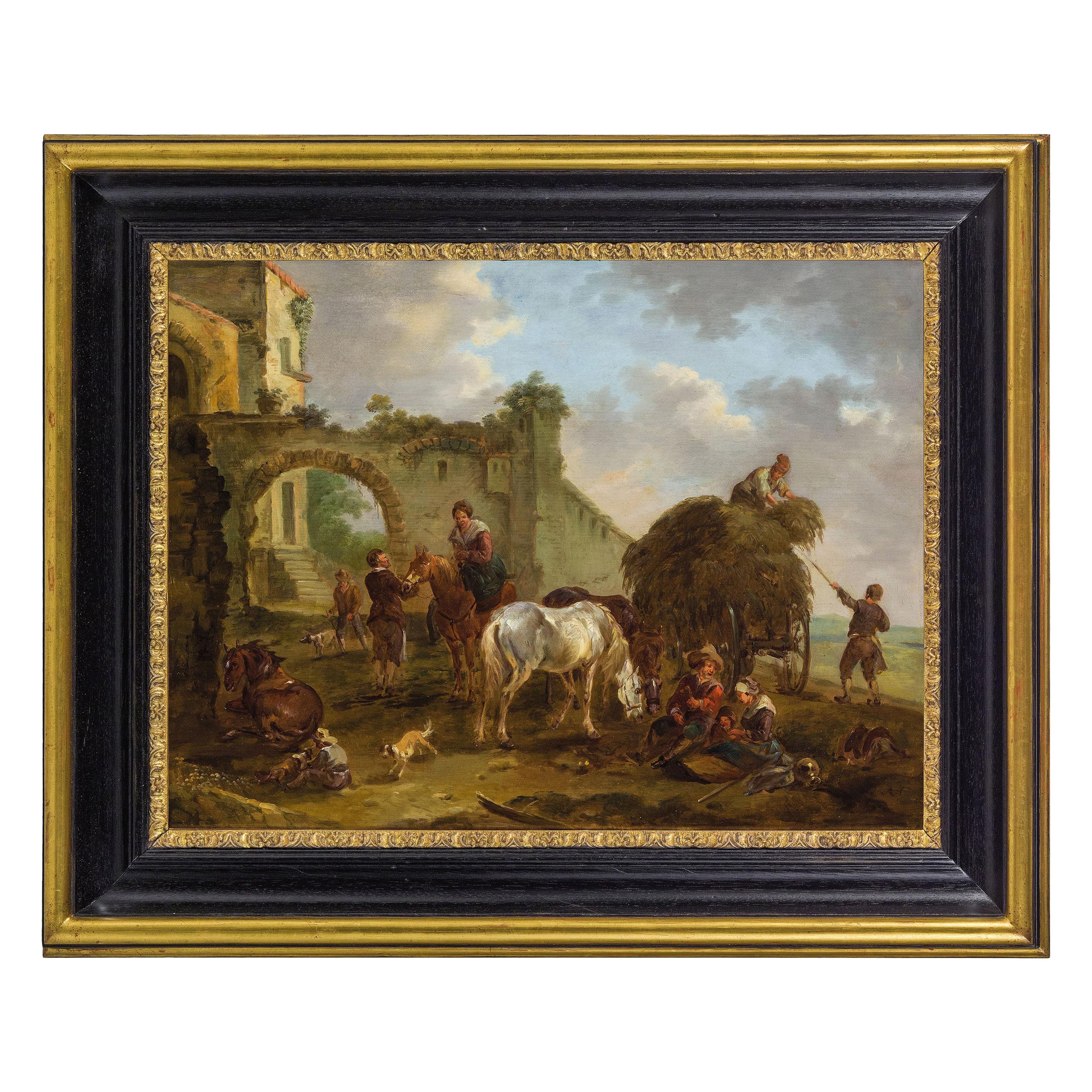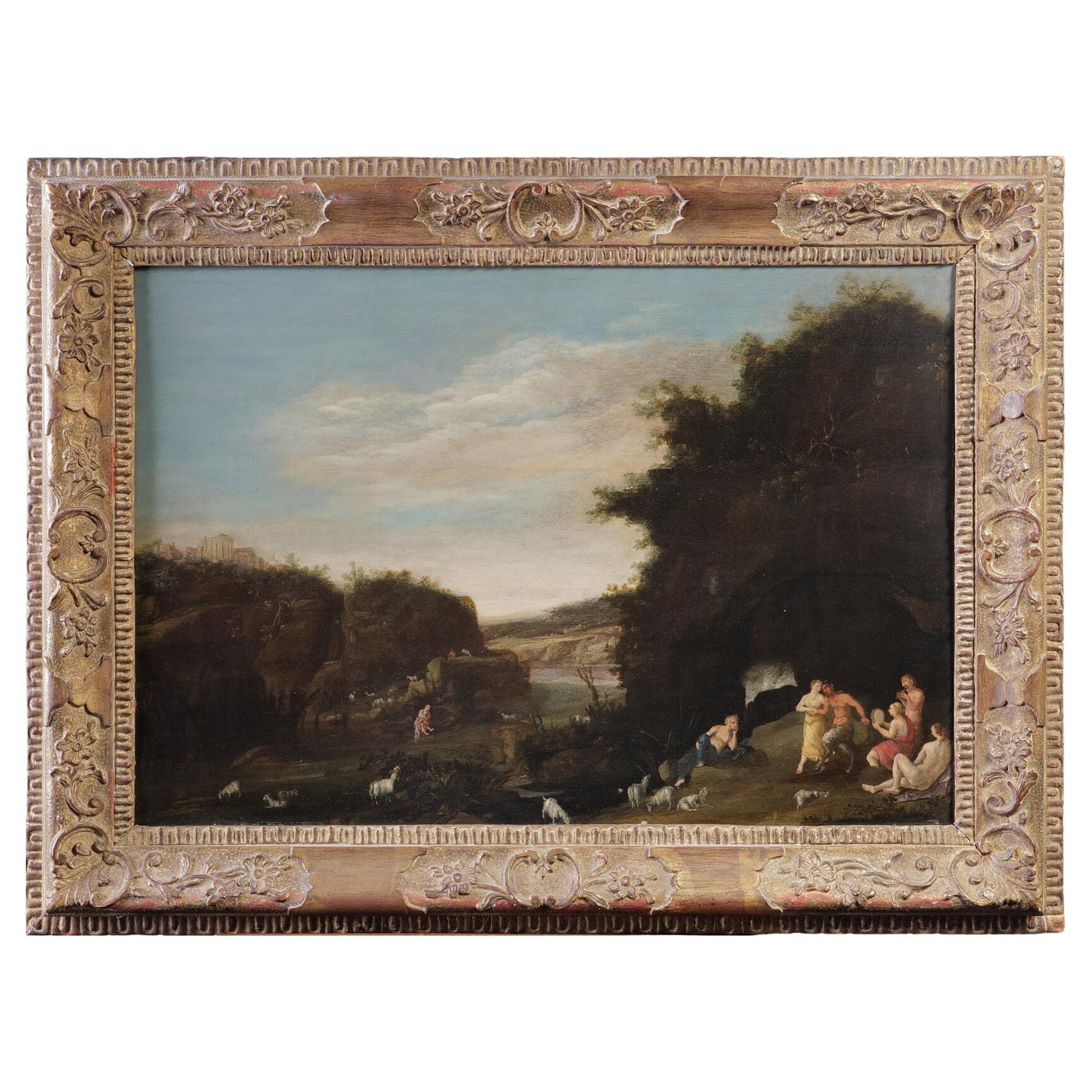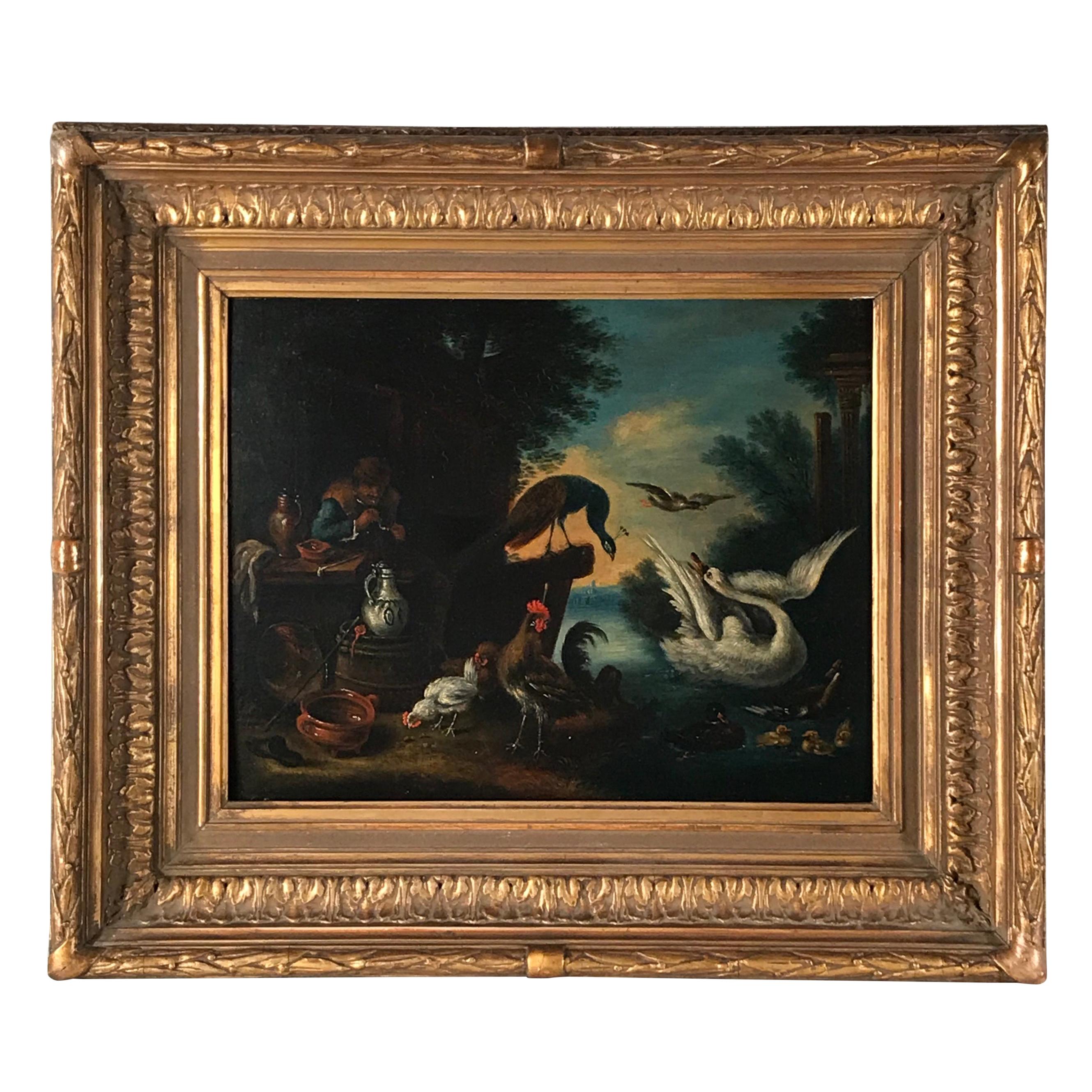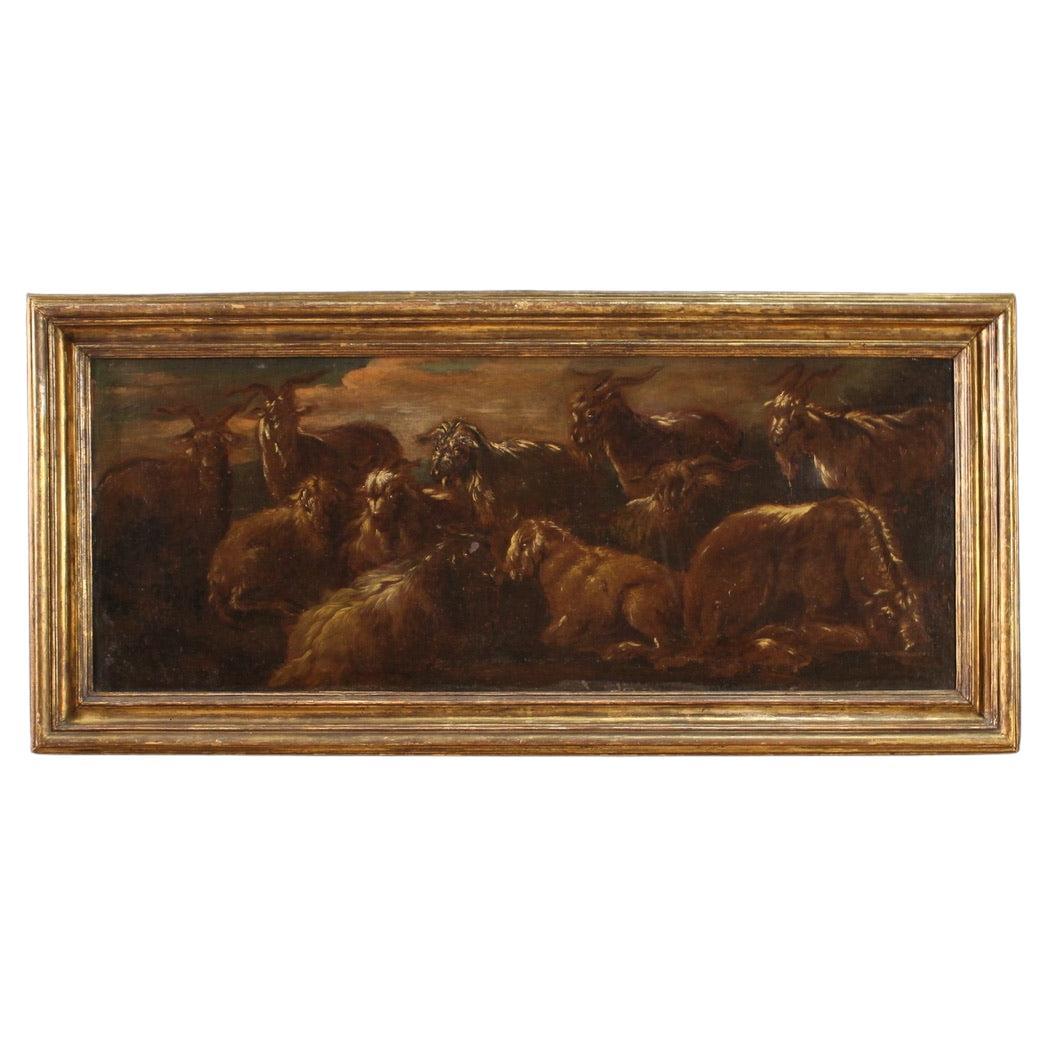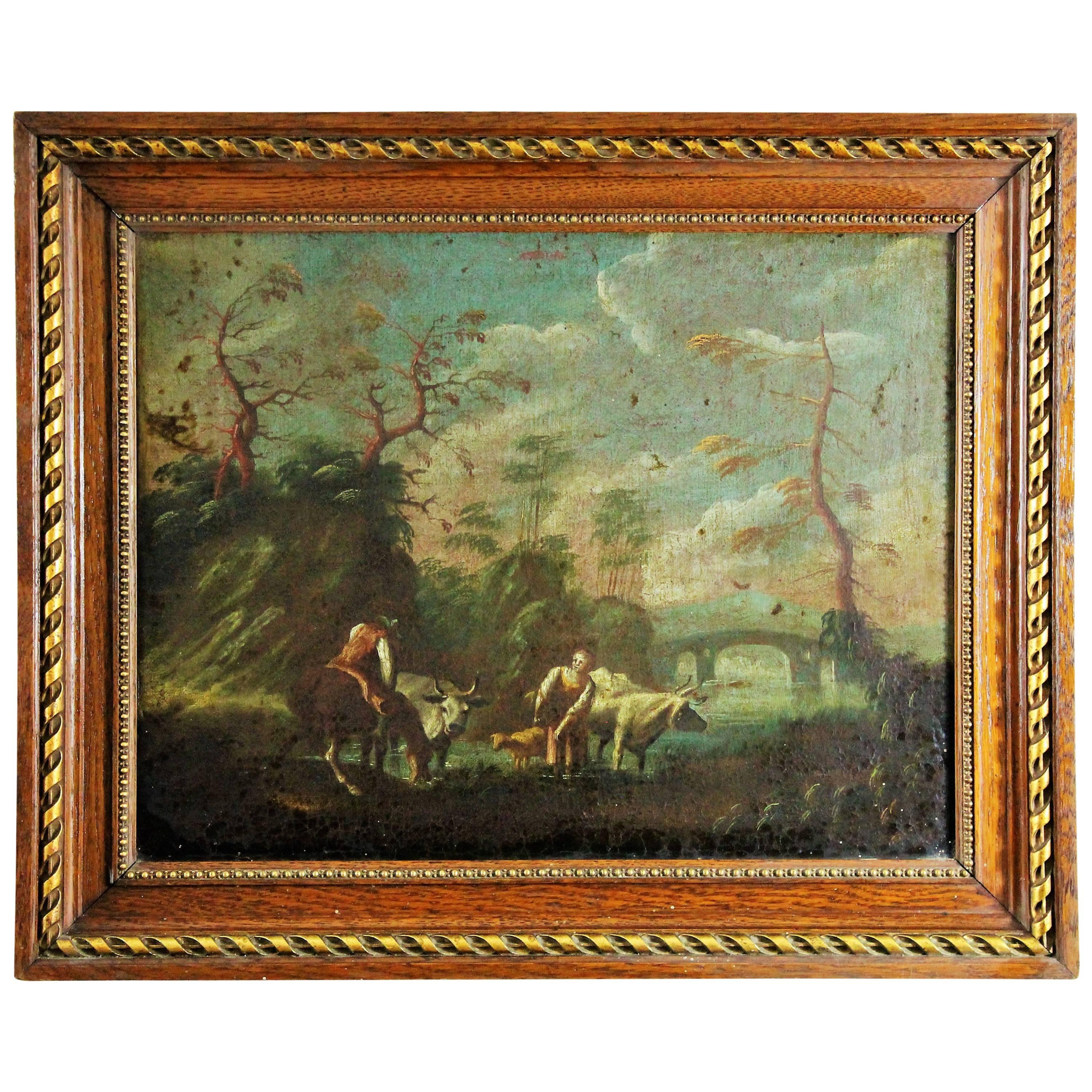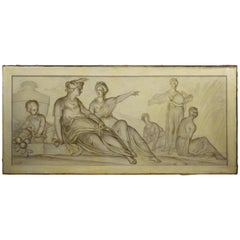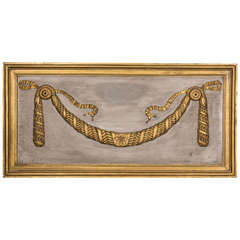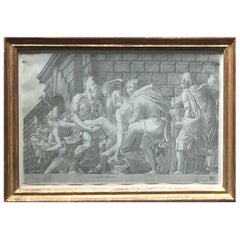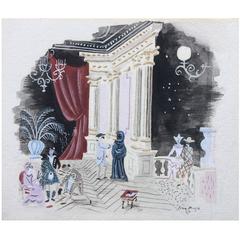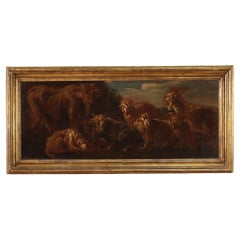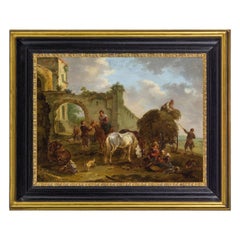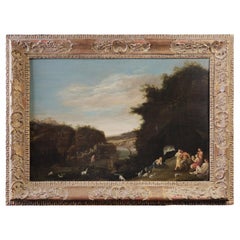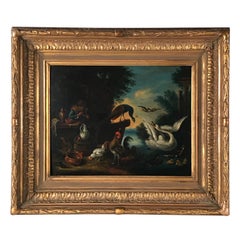Items Similar to 17th Century Rosa di Tivoli Painting on Slate
Want more images or videos?
Request additional images or videos from the seller
1 of 5
17th Century Rosa di Tivoli Painting on Slate
$12,000
£9,105.32
€10,411.12
CA$16,760.75
A$18,635.67
CHF 9,730.52
MX$226,841.47
NOK 124,157.17
SEK 116,329.34
DKK 77,700.13
Shipping
Retrieving quote...The 1stDibs Promise:
Authenticity Guarantee,
Money-Back Guarantee,
24-Hour Cancellation
About the Item
A ram lowers its horns in a face off with a barking dog that rises on its haunches. An ox turns its head to watch the row. An annoyed ewe glances over its shoulder, but the two behind her don't deign to look. A pair of oblivious sheep graze at a distance to the right. Nothing could be more ordinary than a dog corralling a herd before heading home for the night. But what's extraordinary is the painter’s ability to portray an animal-kingdom drama. You might say the scene is the barnyard equivalent of a modern-day subway altercation, more posturing than fight, suggesting, intentionally or not, that the restive behavior of animals has much in common with that of humans.
The painter of this scene was Philipp Peter Roos, better known as Rosa di Tivoli. He was born in Germany to a family of painters who specialized in landscapes and animals. Early on, he worked in Frankfurt am Main under the protection of Charles I, Landgrave of Hesse-Kassel. Knowing talent when he saw it, that beneficent ruler sent the young Roos to Rome to perfect his art in 1677. There, his skill was honed in the studio of Giacinto Brandi. And in Rome he remained, after falling in love with his master’s daughter, Maria Isabella. In 1681, Roos, a Lutheran, converted to Catholicism to marry her. Three years later, they purchased a house in nearby Tivoli where they raised seven children. During those years his surname was Latinized to Rosa, and, following the change of address, he became known to the locals, and to posterity, as Rosa di Tivoli.
Tivoli is celebrated for a landscape of rolling hills garnished with ancient Roman ruins. Among them are the surviving arches of the famous aqueduct, which can be discerned, if just barely, through the evening gloom to the left in our painting. Rosa’s acreage in Tivoli allowed him to keep a menagerie of animals to serve as models, which is why his home was known as Noah’s Ark. Not that Rosa cut a figure of biblical propriety. He was one of many Northern painters then living in Rome who were notorious for carousing. He joined the Bentvueghels (Dutch for “birds of a feather”), a confraternity of German and Dutch painters who met in the Pantheon. That 2nd century temple, originally dedicated to all the pagan gods as its name would suggest, had since been rededicated to St. Mary and the Martyrs. The painters’ meetings there invariably turned into drinking binges, sending members hopscotching from tavern to tavern for weeks at a time. If many contemporary Romans looked down on the antics of these barbaric foreigners, aristocratic connoisseurs bestowed on them their patronage. This is why most of Rosa’s paintings are still to be found in the palazzi of the Colonna, Borghese, Ludovisi, and Doria Pamphilj families.
Connoisseurs were then partial to small jewel-like paintings on hardstones, which were selected for their suitability to the scene being depicted. For example, blue lapis lazuli was matched to scenes unfolding against a daytime sky, and black slate was matched to scenes unfolding against a nighttime sky. Our rustic scene, painted on slate, probably dates to the 1680s. In 1691, by which time dark Caravaggesque scenes like Rosa’s were no longer in vogue, so he had to sell Noah’s Ark, and return to Rome. He died there in poverty at the age of fifty-one. We know this from Arnold Houbraken, his contemporary, who included Rosa in the book he wrote on German and Dutch painters. There, he records: “In the year 1698-1699, the Landgrave of Hessen-Kassel, his first patron, came to Rome, and inquired after our Roos, whether he still lived, and after his conduct in life, and said, when he heard that he had changed his Religion, that I am still able to forgive him, but that he has never sent me a piece of his Art as proof of his gratitude I can never forget.”
- Creator:Philipp Peter Roos (Rosa di Tivoli) (Artist)
- Dimensions:Height: 8.25 in (20.96 cm)Width: 13.5 in (34.29 cm)Depth: 2 in (5.08 cm)
- Style:Baroque (Of the Period)
- Materials and Techniques:Slate,Painted
- Place of Origin:
- Period:1680-1689
- Date of Manufacture:circa 1685
- Condition:Replacements made: The upper right corner of the slate has been filled in and painted later. Wear consistent with age and use. The black-lacquered frame is later.
- Seller Location:New York, NY
- Reference Number:1stDibs: LU1061422880542
About the Seller
5.0
Recognized Seller
These prestigious sellers are industry leaders and represent the highest echelon for item quality and design.
Established in 1994
1stDibs seller since 2014
20 sales on 1stDibs
- ShippingRetrieving quote...Shipping from: New York, NY
- Return Policy
Authenticity Guarantee
In the unlikely event there’s an issue with an item’s authenticity, contact us within 1 year for a full refund. DetailsMoney-Back Guarantee
If your item is not as described, is damaged in transit, or does not arrive, contact us within 7 days for a full refund. Details24-Hour Cancellation
You have a 24-hour grace period in which to reconsider your purchase, with no questions asked.Vetted Professional Sellers
Our world-class sellers must adhere to strict standards for service and quality, maintaining the integrity of our listings.Price-Match Guarantee
If you find that a seller listed the same item for a lower price elsewhere, we’ll match it.Trusted Global Delivery
Our best-in-class carrier network provides specialized shipping options worldwide, including custom delivery.More From This Seller
View AllFrench 18th Century Trompe l'Oeil Painting
By Piat Joseph Sauvage 1
Located in New York, NY
This neoclassical trompe l'oeil painting is an allegory of summer. It would have been hung with allegories of the other three seasons over the doors of a salon. Ceres, Roman goddess...
Category
Antique Late 18th Century French Neoclassical Paintings
Materials
Canvas
$15,000 Sale Price
25% Off
Italian, 18th Century Decorative Panel
By Bonzanigo
Located in New York, NY
A neoclassical painted and gilded overdoor panel in the manner of Giuseppe Maria Bonzanigo, circa 1790.
Category
Antique 1790s Italian Neoclassical Decorative Art
Materials
Wood
16th Century School of Fontainebleau Engraving
By Master F.G.
Located in New York, NY
This 16th century French engraving illustrates an episode in the Trojan War – although the actual one illustrated is in question. According to recent scholarship, it depicts the corp...
Category
Antique 16th Century French Renaissance Prints
Materials
Paper
Small Painting by Jean Hugo from 1927
By Jean Hugo
Located in New York, NY
Great grandson of the famous writer Victor Hugo, the painter Jean Hugo (1894-1984) was in the thick of the Paris art scene between the wars. A member of the avant garde, he was a friend of Picasso, Cocteau and Colette and was associated with the Neo Romantics. His small gouaches on paper were avidly collected by Dr. Albert Barnes, and can be seen today in the Barnes Collection in Philadelphia. Hugo's most desirable work -- landscapes, interior scenes, set designs -- date from the mid 1920s to the late 1930s. This whimsical painting, signed and dated 1927, is set in a curtained, classical interior furnished with Victorian lighting fixtures...
Category
Vintage 1920s French Romantic Paintings
Materials
Gouache
French Trompe L'oeil Drawing Circa 1800
Located in New York, NY
This trompe l'oeil drawing depicts the artist's tools -- a black and a red crayon, and a folding steel ruler that was painted with silver pigments, which have blackened with age. They're shown on a sheaf of papers that include a medieval manuscript page, a musical score, and a group of prints.
The unifying theme is the artistic patronage of the Medici, the Grand Dukes of Tuscany, who intermarried with the Habsburgs, who were the Holy Roman Emperors.
Among the papers are prints by Stefano Della Bella, the Florentine artist who worked for the Medici. They depict a negro page with a horse, and portraits of Lorenzo Lippi...
Category
Antique Early 1800s French Empire Drawings
Materials
Paint, Paper
Emilio Terry 1930s "Louis XVII Style" Bed
By Emilio Terry
Located in New York, NY
Emilio Terry -- architect, interior, and furniture designer -- was the inventor and sole-practitioner of what was drolly referred to as his “Louis XVII style...
Category
Vintage 1930s French Neoclassical Revival Drawings
Materials
Paper
You May Also Like
17th Century Oil on Canvas Italian Landscape with Animals Painting, 1680
Located in Vicoforte, Piedmont
Antique Italian painting from the second half of the 17th century. Artwork oil on canvas depicting a particular subject Grazing animals of good pictorial quality in the style of Rosa...
Category
Antique 1680s Italian Paintings
Materials
Canvas
18th Century, Baroque Austran Painting by August Querfurt
Located in IT
August Querfurt (1696, Wolfenbüttel - 1761, Vienna)
Farmers and villagers at the entrance of a village
Oil on panel , cm 38,5 x 51. frame 66 x 53,5 x 4,5 cm
The valuable painting, ...
Category
Antique 18th Century Austrian Baroque Paintings
Materials
Wood
Daniel Cletcher 17th Century Painting Oil on Wood Panel 1628 Den Haag Flemish
Located in Münster, DE
A landscape with nymphs and satyrs revelling by a stream , 1628
Daniël Cletcher, Den Haag 1599
Died: Den Haag buried on 1632-11-25
Father: Thomas Cletcher sr. (? - ca. 1655)
Mother...
Category
Antique 1620s Dutch Baroque Paintings
Materials
Wood
Unknown Flemish Artist, 18th Century
Located in Belmont, MA
Unknown Flemish Artist, Belgium 18th century, in the right part of the painting the artist represented a man sitting in front of a tavern. He is surrounded by Delft baroque earthenware pitchers and plates. The right side of the painting shows different types of birds, among them chicken, a swan, ducks and a peacock. The painter was here definitely inspired by the 17th century painter Melchior de...
Category
Antique 1770s Belgian Baroque Paintings
Materials
Hardwood
17th Century Oil on Canvas Italian Landscape with Goats Painting, 1680
Located in Vicoforte, Piedmont
Antique Italian painting from the second half of the 17th century. Painting oil on canvas depicting a particular subject Grazing animals of good pictorial quality in the style of Ros...
Category
Antique 1680s Italian Paintings
Materials
Canvas
Oil on Canvas Paint Flemish School, 17th Century Belgium
Located in Beuzevillette, FR
Oil on canvas depicting a country scene: a man watering his horse near a river where two cows and a sheep wade accompanied by a farmer.
Work of northern France or Belgium of the 17t...
Category
Antique 17th Century Belgian Paintings
Materials
Canvas
